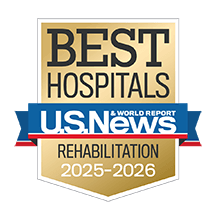Pelvic Therapy

Pain or dysfunction in your bladder, bowel or uterus can be stressful and disruptive. These problems are often caused by issues in the pelvic floor, which is the group of muscles that support your pelvic organs. Pelvic rehabilitation makes those muscles strong and flexible so you can do things like go to the bathroom and maintain intimacy without trouble.
Atrium Health Carolinas Rehabilitation is home to a specialized team of pelvic therapists. We help men and women of all ages — including children who need help with bladder control — manage their pelvic problems and live happy, healthy lives.
Atrium Health Carolinas Rehabilitation is proud to be named a Best Rehabilitation Hospital, ranking in the top 15 nationally and best in the Southeast by U.S. News & World Report.
Patient Care – What to Expect
Our pelvic therapists are specially trained to help with problems in this part of the body. They’re also sensitive to the personal nature of the therapies you’ll be doing together. They’ll be close and supportive partners as you develop the skills and conditioning you need.
Patients choose Carolinas Rehabilitation because we provide:
- Care for all ages: Bladder and bowel issues may be associated with the very young and very old, but they can happen to anyone. Our team has experience with mothers whose pelvic muscles are damaged by pregnancy and childbirth, young adults who develop bladder problems or pelvic pain, toddlers struggling to potty train, and everyone in between.
- Unique expertise: Some of our therapists have their Pelvic Rehabilitation Practitioner Certification (PRPC), which recognizes their experience treating the health and function of the pelvic area in patients of any gender and age. We also have therapists trained in dry needling, a relatively new treatment that uses thin needles to relax tense muscles.
- Personalized care: You see the same therapist, one-on-one, at each session. We listen to you and evaluate your needs carefully. This helps us tailor treatments to your specific condition and goals.
What We Treat
Muscles in the pelvic floor need to be limber to support your pelvic organs and help them function. If the muscles are too tight or too weak, it can cause problems such as:
- Constipation and difficulty having bowel movements
- Leaky bladder or bowel
- Pain during sex
- Pain in the pelvic area
- Pain in the low back and pelvic area during or after pregnancy
- Problems with urination, including straining and going to the bathroom often or suddenly
- Tailbone pain
- The uterus or other organs slipping out of position (called pelvic organ prolapse)
Pelvic Therapy Treatments
We use many different treatments to help you find comfort and control. Many of these are focused on exercising muscles in your pelvic floor. Making these muscles stronger gives pelvic organs the support to help them work and feel better. Our therapy treatments and strategies include:
- Education and behavior strategies: Often, our first step is helping you understand how your pelvic organs should normally function, including how often you should go to the bathroom. From there we can teach you strategies like monitoring your food and water intake and going to the bathroom on a schedule. We also provide information and tools to help reduce pain and other problems with intercourse.
- Manual therapy: Our physical therapists can use specialized techniquess to loosen muscles, joints and nerves in the pelvic floor to reduce pain and help organs function better.
- Exercises: We can lead you through a variety of exercises that strengthen the pelvic floor muscles. This gives your organs proper support and reduces problems like a leaky bladder and the risk of prolapse.
- Dry needling: This is a therapy where we insert thin needles into tense muscles in the pelvic floor to help them relax. We’re one of the only programs in the area with therapists certified to provide this treatment.
- Surface electromyography (SEMG)-assisted biofeedback: Exercising muscles in the pelvic floor can be difficult, because people often don’t know where those muscles are or how to flex them. SEMG-assisted biofeedback is a system that helps you do that. We use sensors attached to your body and connected to a computer, which shows you when you’re activating the right muscles. This is another therapy that not many programs in our region provide.
